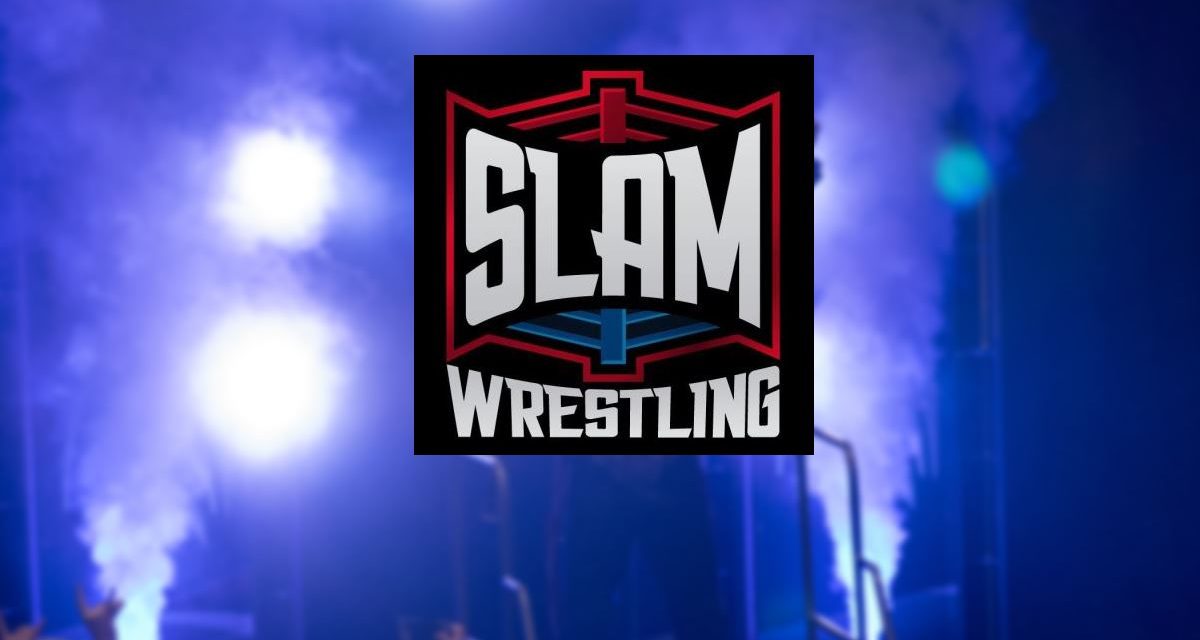He might be the most influential person in sport today. When he first came to prominence on North American television as a WWE superstar, no one could have predicted that he would affect the lives of so many people; that he would provide answers for so many families; that he would change how athletes, doctors, trainers, referees, coaches, parents and administrators respond to head injuries. Chris Nowinski is leading a revolution and revolution might just save someone you know.
Chris Nowinski first made a name for himself on the WWE reality series Tough Enough in 2001. The Harvard graduate and former NCAA football player became interested in professional wrestling while in college.
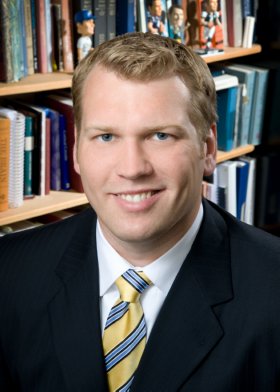
Chris Nowinski
He was briefly trained by wrestling legend Killer Kowalski in early 2001 before sending in an audition tape for the wrestling reality show. His character of Harvard Chris rubbed the audience and fellow competitors the wrong way. Nowinski looked at the competition as a chance to develop a character and get noticed in wrestling. Even though he lost the show to Maven, big things were to come for Nowinski.
On June 10, 2002, Nowinski made his WWE debut helping William Regal defeat Bradshaw. Prior to the match he was quite nervous.
“I was like a kid in a candy store. There were all these guys I looked up to on television that I was now a colleague with in a kind of magical live show. It was fascinating,” Nowinski told SLAM! Wrestling. “Backstage is never what you could possibly imagine. In one hand it was a very fun environment because you are hanging out with all these entertainers and very stressful environment because the way that business is run, you don’t know what is coming next.”
Over the next two years Nowinski became a familiar face on WWE broadcasts. He attributes his early success in the major leagues of wrestling to the help he received. “A lot of people took care of me; Al Snow was there from my Tough Enough days,” said Nowinski. “Stevie Richards was the first one to invite me to travel with him. William Regal, my tag team partner, was endlessly available to help me out. JBL in my first long program taught me a lot… I got to know a lot of guys — Booker T, worked against Goldust, and they were all very helpful.”
In June 2003, Nowinski’s career path and life changed drastically. In a match he experienced what would ultimately be classified as a concussion. For five weeks he tried to work through the pain and nausea he was experiencing. Finally he went to the doctor and found out he had a concussion and was experiencing post-concussion syndrome.
The WWE was concerned about Nowinski’s health. “They (WWE) started finding other doctors to get some answers. They never pressured me in any direct fashion. I am sure they wanted me to get better faster but the never bothered me about it which was very helpful,” recalled Nowinski.
“When I told them I wasn’t going to come back they found things for me to do so like SmackDown Your Vote, Get Real. Which was great because had I been cast out, with headaches for five years, I wouldn’t be able to go back to any kind of job and I would have gone to a much darker place than I did. They kept me as part of the family which was helpful for my recovery,” said Nowinski.

Dr. Robert Cantu.
The WWE continued to help Nowinski through his injury and eventually sent him to renowned neurosurgeon Dr. Robert Cantu. “Whoever was managing me in the WWE with my injury at that time … he called me up, ‘Somebody just told us that there is a great doctor near you about 45 minutes away would you go out and see him?’ So WWE found him by word of mouth,” said Nowinski. “He very quickly opened my eyes to the problem in the meeting. He had been advocating on concussions for decades. He wrote the first return to play guidelines that were published in 1986 and he just knew so much more.”
Nowinski had very little knowledge of what was considered a concussion. Dr. Cantu educated the Harvard graduate. “Very quickly in our discussion he helped me realize that it wasn’t my first concussion that there were many more that I was ignoring as dings and bell-ringers. He made me appreciate that I had to rest my concussion,” said Nowinski. “That blew my mind because I hadn’t heard that from anyone before. Then over time I started to learn about the long term effects of them.”
The effects of his concussions caused a decrease in his quality of life. Over time some things got better, but he has needed some help. “There isn’t a lot you can do for post-concussion syndrome in certain cases. For me, I tried a bunch of medications for the headaches and acupuncture and nothing really helped. It was just time. My brain needed time. With the sleepwalking I was heavily sedated every night so I wouldn’t hurt myself. That also kept me having a good night sleep. I took a stimulant to help my memory,” said Nowinski.
Experiencing the long-term effects of concussions and becoming further educated about the subject inspired Nowinski to write his seminal book Head Games: Football’s Concussion Crisis. The book opened up the eyes of people in professional sports — as well as amateur — about the life-long problems that can occur from concussions. In 2012, Head Games was released as a documentary that has been praised by many.
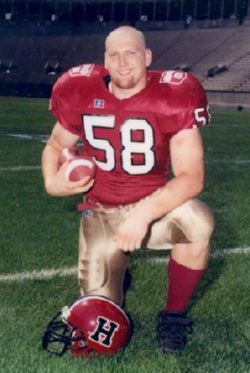
Chris Nowinski while at Harvard.
In 2007, Nowinski teamed with with Dr. Cantu to co-founded the Sports Legacy Institute (SLI) to study,, educate and inform people about concussions in sport, and ideally solve the problem. In 2008, the SLI partnered with Boston University School of Medicine to create the Center for the Study of Traumatic Encephalopathy. This was the first centre of its kind to study chronic traumatic encephalopathy (CTE), which is a degenerative brain disease that is linked to brain trauma such as concussions.
CTE has been at the forefront of Nowinski’s research. “It’s the goal to stop progression before the disease progresses. So we want to catch it before people have symptoms,” said Nowinski. Through the work of the SLI, it is now known that CTE starts in the frontal lobe in athletes. CTE is a characteristic degeneration of brain tissue and the accumulation of tau protein which may result in signs of dementia, aggression, memory loss, depression and confusion years or decades after the concussion. “That means you’ll have problems with things like executive functioning, goal oriented behaviour, planning, concentration, attention.”
In recent years former professional athletes have willed their brains to the SLI to be studied for the disease. In one case — and not the only case — former NFL player Dave Duerson shot himself in the chest. His suicide note stated that he chose this method to preserve his brain for the study of brain trauma.
The work Nowinski has pioneered has helped families understand the behaviours exhibited by their loved ones who have experienced head trauma; in wrestling, the most famous example is the examination of the brain of Chris Benoit after he killed his wife and child, and then himself, in 2007. “People have headaches; people say they have issues with impulse control,” said Nowinski. “And then, you start to see later on, memory problems, actually mood disorders are early too like depression and then you start to see memory problems and then eventually you get to dementia.”
The SLI has had many athletes donate their brains upon passing and the results of their investigations have been staggering. “Playing contact sports recklessly for a long period of time puts you at a very significant risk for chronic traumatic encephalopathy. I don’t think there is any way around that right now,” said Nowinski.
The SLI has been studying the brains of former athletes from many sports. They were very surprised about the pervasiveness of CTE in the first batch of former NFL players’ brains they received. “We don’t know what the prevalence is but it is a miracle coming out of the gate with 52 of 54 NFL players testing positive for CTE. If we even had the 50 first people with dementia we wouldn’t expect 50 to have CTE we would expect them to have Alzheimer’s disease. So there is something going on there. There was actually a big break through earlier this month when the top CTE experts for both the NIH (National Institutes of Health) and the military both said, ‘Let’s stop playing semantics, all the evidence says that CT is caused by trauma.’ No one was willing to say that a few years ago. The top people will say it,” said Nowinski with conviction.
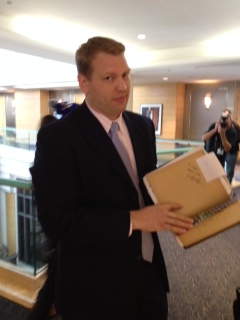
Chris Nowinski at the DSBN Concussion Summit in 2013. Photo by Caleb Smith
With the results piling up showing that CTE is caused by traumatic blows to the brain, does this mean that all sports are dangerous? “I think sports are on a spectrum and within each sport there is a lot about how you play and the decisions you make about the concussions you have, but that has not been proven either,” said Nowinski.
“If you are a boxer for 20 years and you spar a lot and take a lot of blows to the head you have a really high chance of getting this. If you are an ice hockey player and not a fighter then your chances are pretty low unless you have a significant concussion,” pointed out Nowinski. “We just had a baseball player we found with CTE who had 10 concussions … we really don’t understand all of the risks but it has something to do with the severity of the injury you get. Meaning something has to trigger the disease to begin with like a big hit. The repetition one big hit followed by a month off, not as big a deal as one big hit, hide it, get hit in the head a couple of hundred times over the next few weeks.”
Parents and athletes can control the activities they participate in. They can make the decision to play in sports that have a higher chance of concussions than others. “There is a bit about when you play, how you play and what you play. Go to concussionchecklist.org, for a test we’ve created to help parents identify how they can make your kids safer,” said Nowinski. The site has a checklist you can use to see if your sport is taking the precautions necessary, to find out if there are protocols in place for head injuries.
“So some of the bigger messages are no brain trauma is good brain trauma and the young brain is far more at risk for problems so we really encourage parents if possible to postpone exposure to a kid to repetitive brain trauma,” said Nowinski. For example in ice hockey, most leagues have raised the checking age. In soccer, the SLI recommends not heading the ball when young and maybe not until high school. In football there is a very strong argument to be made that you don’t need to play tackle until high school. “Don’t get hit in the head 200-300 times when you are 10 because at that age you are putting the kids at dramatic risk, there isn’t a doctor on the sideline and they don’t understand when they are injured. There is too much out of your control.”
At the present Nowinski and his team are really focused on learning how to diagnose the disease (CTE) and how treat people. Nowinski suggests that they are very close to learning how to diagnose the disease in living people. “We’ve already started to identify treatments in a laboratory model for CTE and so that we were ready when we can diagnose it in people we can start trying to treat humans and that treatment is actually funded by WWE,” said Nowinski.
Another big push for the SLI is doing studies to learn how to better educate athletes. “We haven’t quite learned messaging yet that works which is kind of disappointing,” said Nowinski. “We can teach kids knowledge about concussions, but we can’t seem to change their intentions to report their concussions. So reporting is still terrible. And we’re also looking at things like post-concussion suicide. A lot of the brains that have been donated to us are teenagers who’ve had concussions in the last few days, few weeks, few months and their still suffering symptoms and we want to see if we can screen for that so that we can keep these kids around during that kind of period where their brain isn’t working right.”
Sports leagues in North America have begun to take heed of the SLI’s concussion protocols. The high level of scrutiny and media coverage over the last few years has forced sports leagues to become more aware and proactive about the treatment of concussions. “I think everyone understands the value. It’s more of a problem for some sports than others, so for example, Major League Lacrosse let Dr. Cantu and I and our medical advisors write their concussion protocols and policies from scratch without any push back,” said Nowinski. “At other levels, you know, I think the NFL has done a great job of culture change at the pro level, but there’s concern about how they’re handling the concussion discussion at the youth level. So, I think we’re getting good support from the pro leagues these days.”
Recently Nowinski has been working with professional rugby leagues with great success. “We are getting into rugby with our first CT case. A couple of medical advisers invited me to take part in a working group,” said Nowinski. “South Africa is a beachhead in concussion awareness they do a great job in educating probably better then anywhere else in the world. Now we are in the UK and Australia and we did identify the first Australian CT case in rugby.”
Nowinski points to one case in particular that shows that his work is having a positive impact on athletes. “We may have saved someone’s life with our concussion protocols. A rugby league player broke his neck on impact and didn’t realize it,” said Nowinski. “He walked off the field begging to be put back in after he had been knocked out. It was only that policy they didn’t put him back in. Then he started to sober up and realized his neck was hurting and had two fractured vertebra. We spent time in November in Australia with the executive director of their rugby league association. So it was indirectly part of the pressure from the U.S. changing the rules and partially from that meeting that they realized it was a player welfare issue so before the season the changed their rules.”
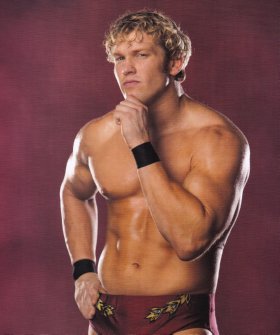
Chris Nowinski in a WWE publicity shot from 2003.
One of Nowinski’s biggest supporters is the WWE. It has been a major player in supporting the SLI. In 2013 the WWE donated $1.2 million to the organization to create a new study towards developing treatment for CTE. Nowinski has been pleased that the WWE has been providing its superstars with the knowledge they need to better understand concussions and CTE.
“They’ve been educating them and this year they’ve brought me in to educate all the superstars. So I trained wrestlers and I went to a RAW in Cleveland and before the show, which is fun for me you know big show in the front row and really interested and supportive and Randy Orton and Christian and you know guys I worked with,” said Nowinski. “A lot of guys walked out saying they were starting to understand what was happening in their brain and they could have some control of their own future. So education is a huge part.”
A large reason the WWE has had great success with its concussion protocols is not just what has been put in place, but the change in culture in the locker room. “When I was there, everyone was worried about missing shows and when I wasn’t reporting my concussions, I was scared,” said Nowinski. “The culture was ‘Don’t talk about it, hide it.’ It wasn’t even like we talked about it with each other. People just didn’t talk about it.”
The WWE management now tells its superstars that they need to inform them of the injury and all that will happen is that the show will be rewritten. “It’s that if you go back out there, you could end up making this a long-term issue or you’re forced to retire and then you really, really mess things up for the company,” said Nowinski. “You know Triple H said that wrestling is better than any other sport in that sense, that you can just rewrite the story line. So there’s no real negative consequences to having a concussion. You know, you might have to miss a big match every once in a while, but they’re clever enough and smart enough to make that work in a story line.”
The WWE policies are very strict in terms of the hoops the superstars have to jump through to be cleared back for exercise, and then work in the ring. “They emphasize cognitive rest, they have the same doctors on the road all the time so they know the guys,” said Nowinski.
RELATED LINK
Caleb Smith enjoyed learning more about CTE and the work that Chris Nowinski has pioneered. The author encourages parents to enroll their children in flag rugby a sport that is tackle free. The kids can tackle when they are older. Check out www.niagaraflagrugby.com.
